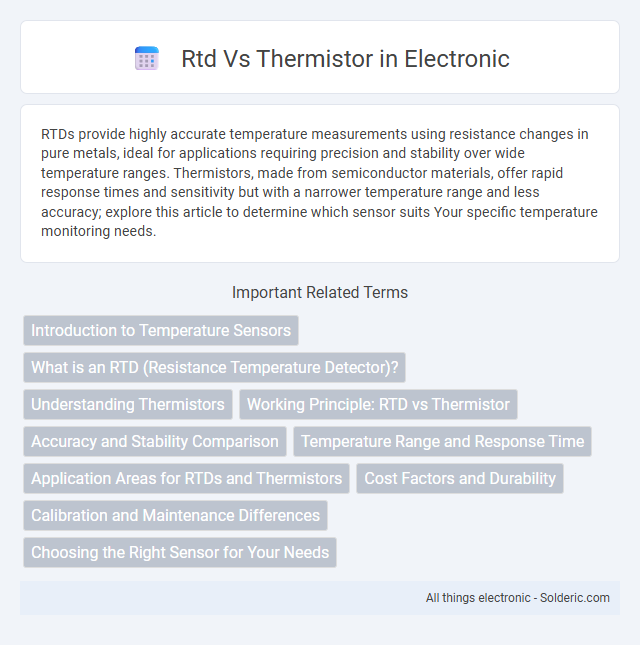RTDs provide highly accurate temperature measurements using resistance changes in pure metals, ideal for applications requiring precision and stability over wide temperature ranges. Thermistors, made from semiconductor materials, offer rapid response times and sensitivity but with a narrower temperature range and less accuracy; explore this article to determine which sensor suits Your specific temperature monitoring needs.
Comparison Table
| Feature | RTD (Resistance Temperature Detector) | Thermistor |
|---|---|---|
| Operating Principle | Resistance changes with temperature (metallic element) | Resistance changes with temperature (semiconductor material) |
| Temperature Range | -200degC to 650degC | -90degC to 130degC |
| Accuracy | High accuracy (+-0.1degC to +-0.5degC) | Moderate to high accuracy (+-0.1degC to +-1degC) |
| Linearity | Highly linear output | Non-linear output |
| Response Time | Slower response time | Faster response time |
| Sensitivity | Lower sensitivity compared to thermistor | Higher sensitivity to temperature changes |
| Stability | Excellent long-term stability | Less stable over time |
| Cost | More expensive | Less expensive |
| Applications | Industrial processes, calibration standards, precise temperature measurement | Battery packs, medical devices, HVAC systems |
Introduction to Temperature Sensors
RTDs (Resistance Temperature Detectors) and thermistors are widely used temperature sensors with distinct characteristics. RTDs offer high accuracy and stability over a broad temperature range, making them ideal for industrial and precision applications. Your choice depends on the required temperature range, sensitivity, and response time, with thermistors providing faster response but limited range and RTDs excelling in durability and linearity.
What is an RTD (Resistance Temperature Detector)?
An RTD (Resistance Temperature Detector) is a precise temperature sensor that measures temperature by correlating the resistance of the RTD element with temperature. Typically made from pure platinum, RTDs provide highly accurate and stable readings over a wide temperature range, making them ideal for industrial applications. RTDs generally offer better accuracy and repeatability compared to thermistors, especially at higher temperatures.
Understanding Thermistors
Thermistors are temperature sensors made from semiconductor materials that exhibit a significant change in resistance with temperature variations, typically classified into Negative Temperature Coefficient (NTC) and Positive Temperature Coefficient (PTC) types. They provide high sensitivity and fast response times, making them ideal for precise temperature measurements in limited temperature ranges, usually from -50degC to 150degC. Compared to Resistance Temperature Detectors (RTDs), thermistors offer lower cost and greater sensitivity but have less linearity and narrower operating temperature ranges.
Working Principle: RTD vs Thermistor
RTDs (Resistance Temperature Detectors) operate based on the principle that the electrical resistance of metals, such as platinum, increases linearly with temperature. Thermistors are temperature-sensitive resistors made from ceramic materials whose resistance changes exponentially with temperature, categorized into NTC (Negative Temperature Coefficient) and PTC (Positive Temperature Coefficient) types. The RTD's linear resistance-temperature relationship enables high accuracy and stability over a wide temperature range, while thermistors offer high sensitivity with rapid response but typically have a more limited temperature range.
Accuracy and Stability Comparison
RTDs offer higher accuracy and long-term stability compared to thermistors, making them ideal for precise temperature measurements in industrial applications. Thermistors provide good sensitivity but can drift over time and are less stable at extreme temperatures. Your choice depends on the need for consistent accuracy and reliability in temperature monitoring over extended periods.
Temperature Range and Response Time
RTDs (Resistance Temperature Detectors) typically operate accurately within a wide temperature range of -200degC to 850degC, offering stable readings at higher temperatures. Thermistors generally function within a narrower range, approximately -50degC to 150degC, but provide faster response times due to their smaller thermal mass. The faster response of thermistors makes them ideal for applications requiring rapid temperature changes, while RTDs excel in environments demanding precise and stable measurements over extended temperature ranges.
Application Areas for RTDs and Thermistors
RTDs are commonly used in industrial processes, HVAC systems, and laboratory settings where high accuracy and stability over a wide temperature range are essential. Thermistors excel in consumer electronics, medical devices, and battery management systems due to their fast response times and sensitivity in limited temperature ranges. Your choice between RTDs and thermistors depends on the specific temperature range, accuracy requirements, and environmental conditions of the application.
Cost Factors and Durability
RTDs generally have a higher initial cost than thermistors due to their complex construction and precise materials, making them an investment for applications requiring long-term stability. Thermistors offer a more budget-friendly option with lower upfront expenses but may experience faster degradation over time, especially in harsh environments. Your choice depends on balancing upfront costs against durability needs and maintenance frequency in your specific temperature sensing application.
Calibration and Maintenance Differences
RTDs require periodic calibration using precision resistance measurement instruments to maintain accuracy, as their resistance changes predictably with temperature. Thermistors, while initially calibrated at the factory, often need less frequent recalibration but can drift over time due to their non-linear response and sensitivity to environmental factors. Maintenance for RTDs typically involves regular electrical checks and insulation resistance tests, whereas thermistor maintenance centers on monitoring for physical damage and changes in resistance characteristics.
Choosing the Right Sensor for Your Needs
RTDs (Resistance Temperature Detectors) offer high accuracy and stability, ideal for precise temperature measurements in industrial applications. Thermistors provide fast response times and greater sensitivity at lower cost, suited for consumer electronics and HVAC systems. Choosing between RTD and thermistor depends on factors like required accuracy, temperature range, environmental conditions, and budget constraints.
rtd vs thermistor Infographic

 solderic.com
solderic.com